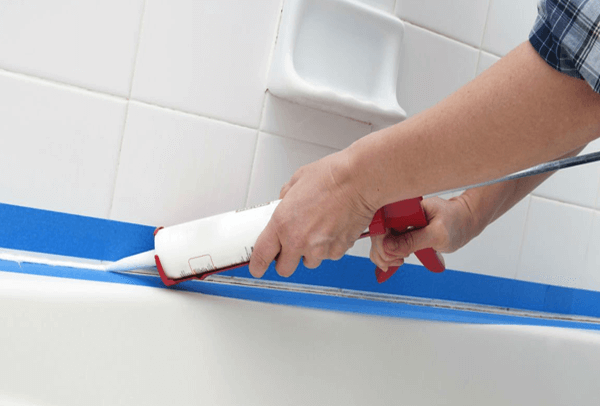Caulk is a must ingredient that is widely used in home renovation projects. From sealing a bathtub to joining or fixing a broken door, we can’t imagine anything without a caulk. But it takes time to cure for proper adhesion. If it gets wet before curing, it may lead to serious problems.
Now, you may ask- what happens if caulk gets wet before it cures?
In this case, it prevents the moisture from evaporating faster. In return, it prolongs the drying time. It means you will not get the right adhesion.
From this guide, you will know how it could be detrimental if the caulk wet before curing. So, continue to read without skipping the page.

Contents
What happens if caulk gets wet before it cures
If caulk gets wet before curing, it may lead to the following problems.
Difficult to gain proper adhesion
The moisture can’t vaporize quickly if the caulk is wet before it cures. In return, it may prolong the drying time of the caulk. At worst, it may prevent gaining proper adhesion.
The caulk may split
High-moisture or humid areas may cause the caulking to split. Also, the caulk will burst if you leave it on water or rain. To avoid splitting, you can wrap the tube with duct tape. Plus, keeping the caulk away from the moisture and humid area will be an effective way to avoid this situation.
Impede bonding
Dirt, mold, and moisture prevent the caulk from bonding objects one with another. Even it will be a reason to fall the caulk off instead of sticking with the surface. We recommend you clean the area optimally. Then, eliminate excess water or moisture to get rid of this problem.
May lead to grow mold & mildew
The purpose of applying caulk is to seal and protect an area from moisture, dirt, and mold. But if there is moisture in the caulk, it does more harm than anything good. In the worst case, it helps to grow mold and mildew.
Prolonged the curing time
If the caulk gets wet, it prolongs the curing process. High-moisture in the caulk doesn’t only delay the drying time but also extends the curing process. You can run a fan to make the process fast.
How to cure silicone caulk faster
Following the below steps, you can make the caulk cure faster.
Apply the caulk rightly
The best way to cure the silicone caulk faster is to apply the caulk correctly. If you apply it heavily, it takes time to dry and the cure time accordingly.
Before applying it, make sure you cut the nozzle cap with a sharp blade. It helps to keep the applicator tip slim. The narrow tip will help to create a slimline which helps to make the curing time faster.
When applying the caulk into the joint, make sure you use them at a 45-degree angle. After using, remove the excess caulk from the area with a clean towel.
Make the drying process faster
Running a fan will help to speed up the drying process. You can also place a humidifier beside the caulking to dry it quickly.
More on LivingProofMag
How Long Does Plumbers Putty Take to Dry
How to Use Plumbers Putty on Kitchen and Bathroom sink
Does Liquid Nails Work On Plastic
Will caulk cure if it gets wet?
Well, if your caulk gets wet before it completely dries up, then the moisture can’t evaporate quickly and its formula cannot work well, which can cause lots of problems over time. For example, the caulk takes a longer time to dry up and it becomes next to impossible to have proper adhesion, leading to gaps and leaks. Additionally, too much moisture before drying properly can also result in the growth of mold and mildew. Remember, caulk cures quicker in a dry surrounding, therefore, always try to let the caulk dry in a well-ventilated environment.
When can I shower after caulking?
Depending on the caulk you are using, the cure times of the caulk vary, and the time is usually mentioned in the packaging by the manufacturer of the product. It is highly recommended by the experts that fresh silicone or acrylic caulk should be allowed to dry up at least overnight or for 12 hours. You can also make sure the caulk is completely cured and 100% waterproof by allowing it to set in its place for around 24 hours before using the shower. Mind you, to play it safe, even products that are fast-drying have got to be given a minimum of 3-12 hours to cure before water exposure.
How do you know if the caulk is cured?
Typically caulk takes up to a couple of minutes to an hour to cure after the application. Though it feels dry to the touch after a few minutes, it doesn’t mean that it is fully cured and waterproof. The best possible way to know when the caulk is cured or dry is to follow the cure times provided by the manufacturer for the product you’re using. One thing to remember is that caulks come with a limited expiration date, and once your caulk is out of date, then it may never cure. You can try it out by applying a little bit on a nonporous surface, and then observe whether or not the caulk is pliable and rubbery after 24 hours.
Conclusion
From the above discussion, we learned what happens if caulk gets wet before it cures.
To avoid the damage, we recommend you learn how to apply the caulk correctly. Also, make sure you clean the surface thoroughly. Otherwise, the object you are trying to seal will fall.
Do you have any questions about the term? Then, don’t forget to let us know by leaving a comment below.
